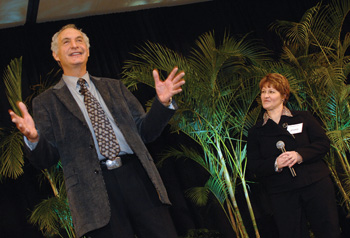Managing innovation key to improvement

Motivational speaker Carl Hammerschlag, M.D., and VUMC’s Jill Austin at last week’s meeting. (photo by Dana Johnson)
To many Americans, the apparent inadequacy and wastefulness of health care delivery is increasingly unacceptable.
Throughout the U.S. system, there is a yawning gap between what is known to work best and what is actually done — a signal that it's time to look beyond traditional improvement strategies to find better ways to bring the delivery of care more reliably in line with agreed best practice.
These observations were the starting point for an address last week by Bill Stead, M.D., associate vice chancellor for Strategy/Transformation, and chief information officer at Vanderbilt University Medical Center. The occasion was the ninth Leadership Development Institute, a quarterly series of elevate management seminars. About 770 managers and faculty leaders attended one of two daylong seminars held Feb. 15 and 16 at Embassy Suites Hotel in Cool Springs.
The theme was innovation. The underlying health care quality and efficiency gap is around 40 percent, Stead said. Without true innovation, the best the system would be apt to achieve would be incremental change.
Stead reminded the crowd that clinical decisions are based on an expert's evaluation of both the patient record and the relevant biomedical evidence. That decision model, established more than a century ago, is now seriously in question. Some 900,000 biomedical research papers and scores of new clinical guidelines are published each year. To decide a patient's best course of treatment, the number of facts one would need to wield has grown far beyond our cognitive capacity, Stead said — at least where more complex patients are concerned.
“All of our research progress is simply creating more things than our human heads can handle. And this cognitive overload is growing larger by the day.
“I suggest we may need a different model for decision making. I don't know what the right model is, I just know it has to be radically different from what we have today,” Stead said.
True innovation can produce discontinuous change, like the change from long-distance train travel to air travel. If we're to arrive at any worthwhile new model for clinical decision-making, Stead said, “Innovation needs to be part of our day jobs.”
He sketched a prospective model for clinical decision-making, presenting a simple diagram of information flow, with a computer terminal at the center labeled “personalized knowledge base,” two input arrows marked “evidence” and “patient record,” and two output arrows leading to the clinician and the patient. He also screened a short video with actors playing a patient and a doctor meeting over a computer terminal, clicking through decision support information to find the blood pressure medication likely to work best given the patient's genetic profile.
As he turned to management strategies to foster innovation, Stead offered more definite prescriptions, including:
• Get the right people in the room and begin by generating a shared vision. Traditionally a project timeline would be based on consideration of a project's scope and the available resources, but Stead turns that around — set your timeline first, then worry about the scope and the resources.
• Break your project into “swim lanes,” the idea being never to undertake sequential efforts when you can instead undertake parallel, coordinated efforts.
• Instead of designing a finished product off the bat, let your design take shape through successive testing.
“To succeed, fail early and fail small” has become a formula with Stead.
When he began describing how these project strategies apply to efforts to improve medication safety, it started to become clear that Stead was unfolding a leadership plan for discontinuous change at the Medical Center, a plan already under way.
The goal is best-of-class medication safety. It's hoped that achieving such a major distinction will go a long way toward once and for all converting VUMC to an organizational culture that, as Stead put it, “values evidence-based, individualized, systematic care.” Given the particular challenges facing health care today, it's thought that successful change along these lines could make VUMC a singularly influential institution for this new century.
Harry Jacobson, M.D., vice chancellor for Health Affairs, started the day with a review of recent progress toward elevate goals for quality, service, patient and employee satisfaction, finance and growth. Jacobson will give a more thorough presentation in his annual State of the Medical Center address to staff and faculty, coming up Monday, March 5, 4 p.m., at the Student Life Center.
The afternoon portion of the seminar featured a motivational speech by Carl Hammerschlag, M.D., a psychiatrist, author, and proponent of psychoneuroimmunology, also called mind-body-spirit medicine. The wide-ranging talk, “Innovation and Transformation: A Journey Inward,” looked at some spiritual aspects of healing.
Presentations from the seminar are available on the elevate Web site, www.mc.vander-bilt.edu/elevate, under “Leadership Development Institute.













